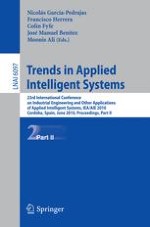2010 | Buch
Trends in Applied Intelligent Systems
23rd International Conference on Industrial Engineering and Other Applications of Applied Intelligent Systems, IEA/AIE 2010, Cordoba, Spain, June 1-4, 2010, Proceedings, Part II
herausgegeben von: Nicolás García-Pedrajas, Francisco Herrera, Colin Fyfe, José Manuel Benítez, Moonis Ali
Verlag: Springer Berlin Heidelberg
Buchreihe : Lecture Notes in Computer Science
